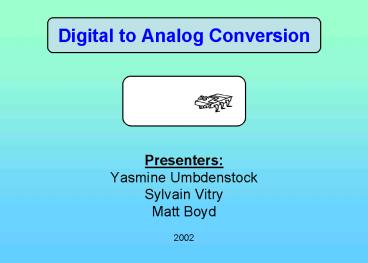Digital to Analog Conversion - PowerPoint PPT Presentation
1 / 30
Title:
Digital to Analog Conversion
Description:
A Digital-to-Analog Converter uses an analog reference voltage to convert a ... signal from the microcontroller to an analog signal used to actuate the valve. ... – PowerPoint PPT presentation
Number of Views:274
Avg rating:3.0/5.0
Title: Digital to Analog Conversion
1
Digital to Analog Conversion
- Presenters
- Yasmine Umbdenstock
- Sylvain Vitry
- Matt Boyd
2002
2
Outline
- What is DAC ?
- DAC specifications
- Resolution
- Speed / Settling Time
- Errors
- Linearity / Monotonicity
- Glitching noise
- Types of DAC
- Reference Voltages
- Binary Weighted Resistor
- Inverted R-2R Ladder
- Applications
3
What is DAC ?
A Digital-to-Analog Converter uses an analog
reference voltage to convert a N-bit digital
input word into an analog output signal.
Vout KVref(b12-1b22-2bN2-N) K gain
of the converter
The analog output voltage can only change in
discrete steps. Practically, it is filtered to
obtain a continuous signal.
4
DAC Specifications
Resolution 1 LSB 1V Operating range ?Vmax
07 V Vref 8 V
Operating range (?Vmax) Bounded range of
possible output voltage values
Resolution Unitary step size for DAC output
5
DAC Specifications (Contd)
Dynamic range r 20log10(23-1) 20log10(7)
17db
6
DAC specifications (Contd)
Settling time actual amount of time it takes a
DAC output to reach its final value (within a
certain percentage) once the input state has
changed
7
DAC Errors
8
DAC Linearity Errors
9
Monotonicity
10
Glitching noise
11
Typical DAC configuration
- Internal reference voltage
- ? Qualified only for a limited
temperature range - External reference voltage
- Multiplying mode possible digital
potentiometer
12
Binary weighted DACs
Resistive network vs Capacitive network
13
Binary Weighted Resistor DAC
14
Binary Weighted Resistor DAC (Contd)
Example problem Find Itot and Vout for a 4-bit
binary weighted resistor DAC where the digital
input code is 1001, Vref -10V and Rf 10k?.
15
Binary Weighted Resistor DAC (Contd)
16
Inverted R-2R Ladder DAC
17
Inverted R-2R Ladder DAC (Contd)
18
Example AD5300
19
DAC Applications
- There are many, many systems that use
digital-analog conversion - Oscilloscopes
- Digital Telephones
- Data Acquisition/Control Systems
- CD Players (Delta-Sigma Modulation)
20
DAC Applications Oscilloscopes
- This digital oscilloscope takes two analog
signals and converts them into digital form.
Then they are converted back so they can be
represented as x and y amplitudes on the screen.
21
DAC Applications Digital Telephones
- Digital phones take an analog voice, convert it
to digital, and then back to analog. - Before digital technology, the signal was analog
the whole way. - With digital technology, several signals can be
transmitted together. - This is made possible by using ADCs and DACs!
22
DAC Applications Data Acquisition
- This data acquisition system takes an analog
input from a sensor and converts is to digital
form used by the PC. The PC user can then use
the digital data or send it to the DAC to get an
analog output.
23
DAC Applications Control Systems
- This actuator control circuit uses a
microcontroller to open and close a valve. The
DAC is used to convert the digital signal from
the microcontroller to an analog signal used to
actuate the valve.
24
CD Players and Delta-Sigma Modulation
- The larger the number of bits, the more resistors
are required. For most CD players, a 16-bit DAC
would be required which would consist of at least
16 matched resistors. - Instead a CD player uses a delta-sigma modulator
and a 1-bit DAC.
25
CD Players and Delta-Sigma Modulation
- The delta-sigma modulator circuit translates a
binary number into a pulse train with a duty
cycle proportional to that number. The pulse
train is then converted into an analog signal by
averaging it over time with a low-pass filter.
26
CD Players and Delta-Sigma Modulation
Delta this part of the circuit creates an error
signal based on the difference between the
incoming binary signal and the outgoing pulse
train.
Sigma this part of the circuit adds up the
results of the error signal created by delta and
supplies it to the low-pass filter
27
CD Players and Delta-Sigma Modulation
- Advantages and Disadvantages of Delta-Sigma
Modulation - Advantages
- Cheap only comprised of two summing chips, a
clock, a comparator, and a low-pass filter. - All-digital circuit that produces an analog
output. - Disadvantages
- Large clock speed required. For an n-bit number,
the clock must be 2n times as fast as the sample
rate. - The output is very sensitive to the accuracy of
the clock pulses.
28
DAC and the HC11
- There is no on-board DAC included in the HC11
- Most DACs can be interfaced with the HC11, but
some require more complex hardware and software
than others. - Since the HC11 is an 8-bit microprocessor, an
8-bit DAC is the easiest to interface with. - Connect the DAC to the parallel I/O port (Port
C). - Simply write something to port C and signal the
DAC to begin.
29
References
- DAC
- http//www.analog.com
- http//www.hcc.hawaii.edu/richardi/113/c113_4e/4e
_1/4e1.htm - http//www.microelectronic.e-technik.tu-darmstadt.
de/lectures/summer/mes/ - download/ppt/da_ad_converters/sld001.htm
- Delta-sigma Modulation
- http//www.ee.washington.edu/conselec/CE/kuhn/oneb
it/primer.htm - Application CD-Player
- http//www.tc.umn.edu/erick205/Papers/paper.html
dacs
30
Questions?































